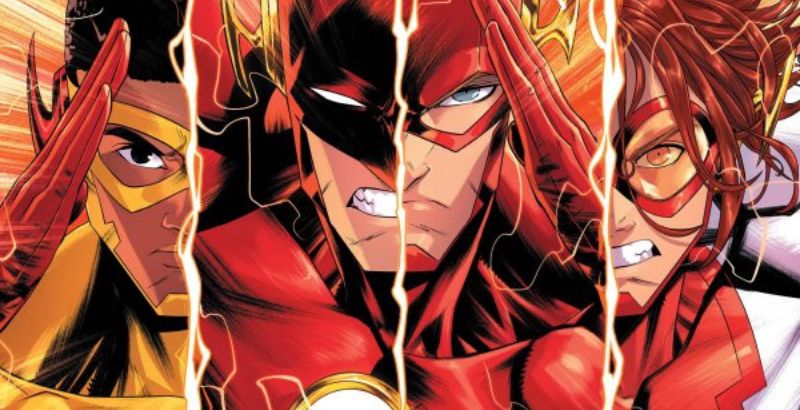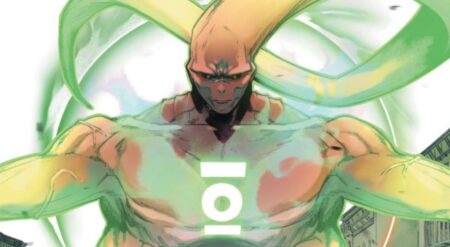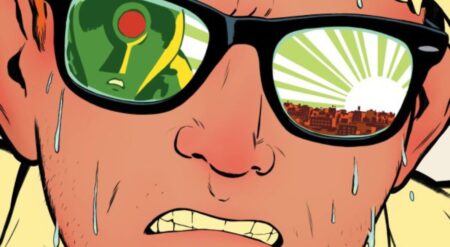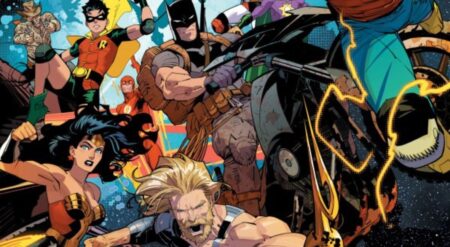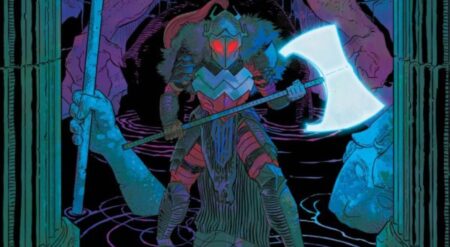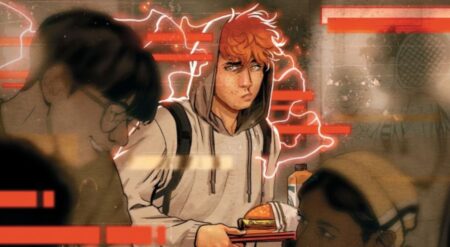The Flash: One-Minute War Special #1 is a one-shot by DC Comics featuring a variety of creators. The first story is titled “Past” and is written by Jeremy Adams, pencils by Fernando Pasarin, inks by Matt Ryan and Jason Paz, colours by Matt Herms, and letters by Rob Leigh. The second story is titled “Present Part One” and is written by Adams, art by Serg Acuña, colours by Rebecca Nalty, and letters by Leigh. The third story is called “Present Part Two,” written by Adams, art by Lisandro Estherren, colours by Patricio Delpeche, and letters by Leigh. The fourth and final story is titled “Future,” written by Adams, art by George Kambadais, colours by Herms, and letters by Leigh. This whole issue is focused on The Fraction, the villains of the One-Minute War, a race of people that have managed to control the Speed Force and are using it to lay waste to other worlds.
This issue tells a vast story, demonstrating the expanse of time as this new and mysterious race exerts their dominance on everything and everywhere. Adams controls the tempo of each chapter well, changing the tone and making all four seem like different stories. The first is a great origin story with grandiosity and an encyclopedic atmosphere. The second and third are action-packed adventures that detail how other super-powered beings are battling and dealing with the invasion forces.
The circumstances expand the impact zones and show a much wider breadth of the story than initially believed. Both parts of the Present part are varied but existing pieces of action, with one classic superhero and the other more sinister and horror-affiliated. It can be difficult to fully find a sense of place or stability within this one-shot and it isn’t easy to latch on to the concept. What is hinted at is not actually clarified, so being certain of the time and place is tricky. But the high intensity of the later chapters makes it a lot of fun to read.
Adams does a great job of including some outside characters and accessing alternate timelines and worlds to find some hidden gems. They are their own personalities and show a variety of reactions towards the oncoming storm. But at the same time, the focus is on the Fraction. The origin story is very high-concept and hard sci-fi. The figurehead, who was first introduced in the opening issue of the One-Minute War, seems like a truly evil character, and that can be somewhat refreshing.
The megalomaniacal dialogue is exciting. Most of the other characters included are speedsters, due to them being the only ones that can even function during the time-pauses the Fraction activate. But it’s a brilliant reminder of the spectrum of speedsters that exist across the Multiverse. There are a couple in the final story that have been collected from alternate-timeline tales. It hints at a dark future where the Fraction remains a presence across all worlds.
The art is a fascinating blend across the stories. The change in artists is brilliant for altering the tone and intentions of each chapter. For the first, worldbuilding is important. The artists superbly craft the homeworld and further planets, with stunning amounts of intricate details.
There is a simplicity to the regular soldier designs that work really well within the abundance of specificity of the backgrounds. Each of the encounters with other beings in Chapter Two has a totally contrasting art style. The first has very expressive characters, as they have large eyes and mouths to denote dynamic emotions. It keeps close to the hero and moves at speed.
The second story is much darker and mysterious, featuring painted techniques. The figures look unnerving and creepy. The soldiers have been adjusted to fit the style, moving through a mansion straight out of a horror movie. The pace and movements are slower. The speedster involved is obscured for most of the story, but his design is strange but mesmerising. The final story has some really interesting ideas with its perspective, often stretching and twisting bodies. It gives the chapter a unique energy that is especially refreshing coming from the darkness of the previous parts.
The colours are clever and stunning in every single story. The style changes with the art which gives each part its own atmosphere. Some are brighter and help display every part of the panel, whereas others enjoy the shadows and the tension that comes with it. The lettering is consistently great throughout the book, with the use of SFX varying throughout the comic.
The Flash: One-Minute War Special #1 is terrific. It serves as a backstory that may be considered too hefty in the main storyline. But it isn’t just a history lesson, using the different points in time to show more than a prologue.
The Flash: One-Minute War Special #1
TL;DR
The Flash: One-Minute War Special #1 is a massive tie-in powered not just by Adams but by a whole host of amazing artists that demonstrate speed in their own unique ways.

